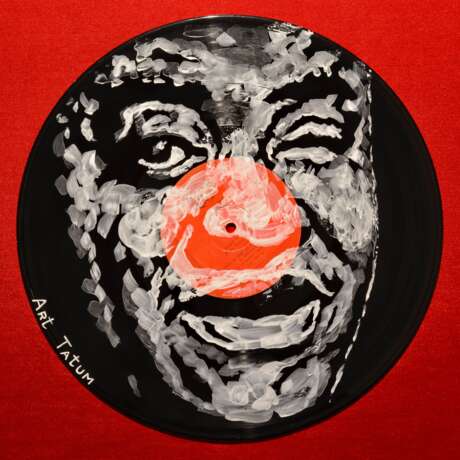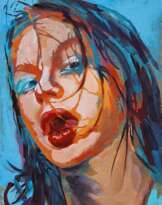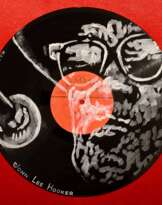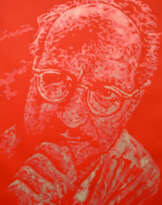Professor Longhair & Art Tatum Acrylic painting Modern art 2013
Yury Ermolenko, ''Professor Longhair'' - Facevinyl - THE BIG COLLECTION - №76, side I, 2013, acrylic on vinyl. The History of Jazz and Blues.
Yury Ermolenko, ''Art Tatum'' - Facevinyl - THE BIG COLLECTION - №76, side II, 2013, acrylic on vinyl. The History of Jazz and Blues.
Henry Roeland "Roy" Byrd (December 19, 1918 – January 30, 1980), better known as Professor Longhair or "Fess" for short, was a New Orleans blues singer and pianist. He was active in two distinct periods, first in the heyday of early rhythm and blues and later in the resurgence of interest in traditional jazz after the founding of the New Orleans Jazz and Heritage Festival in 1970. His piano style has been described as "instantly recognizable, combining rumba, mambo, and calypso."
The music journalist Tony Russell (in his book The Blues: From Robert Johnson to Robert Cray) wrote that "The vivacious rhumba-rhythmed piano blues and choked singing typical of Fess were too weird to sell millions of records; he had to be content with siring musical offspring who were simple enough to manage that, like Fats Domino or Huey "Piano" Smith. But he is also acknowledged as a father figure by subtler players like Allen Toussaint and Dr. John."
In the 1940s, Professor Longhair was playing with Caribbean musicians, listening a lot to Perez Prado's mambo records, and absorbing and experimenting with it all. He was especially enamored with Cuban music. Longhair's style was known locally as "rumba-boogie". Alexander Stewart stated that Longhair was a key figure bridging the worlds of boogie-woogie and the new style of rhythm and blues. In his composition "Misery," Professor Longhair played a habanera-like figure in his left hand. The deft use of triplets in the right hand is a characteristic of Longhair's style.
Tresillo, the habanera, and related African-based single-celled figures have long been heard in the left hand-part of piano compositions by New Orleans musicians, such as Louis Moreau Gottschalk ("Souvenirs from Havana", 1859) and Jelly Roll Morton ("The Crave", 1910). One of Longhair's great contributions was the adaptation of Afro-Cuban two-celled, clave-based patterns in New Orleans blues. Michael Campbell stated, "Rhythm and blues influenced by Afro-Cuban music first surfaced in New Orleans. Professor Longhair's influence was ... far reaching. In several of his early recordings, Professor Longhair blended Afro-Cuban rhythms with rhythm and blues. The most explicit is 'Longhair's Blues Rhumba,' where he overlays a straightforward blues with a clave rhythm." The guajeo-like piano part for the rumba-boogie "Mardi Gras in New Orleans" (1949) employs the 2-3 clave onbeat/offbeat motif. The 2-3 clave time line is written above the piano excerpt for reference.
According to Dr. John (Malcolm John "Mac" Rebennack, Jr.), the Professor "put funk into music ... Longhair's thing had a direct bearing I'd say on a large portion of the funk music that evolved in New Orleans." This is the syncopated, but straight subdivision feel of Cuban music (as opposed to swung subdivisions). Alexander Stewart stated that the popular feel was passed along from "New Orleans—through James Brown's music, to the popular music of the 1970s," adding, "The singular style of rhythm & blues that emerged from New Orleans in the years after World War II played an important role in the development of funk. In a related development, the underlying rhythms of American popular music underwent a basic, yet generally unacknowledged transition from triplet or shuffle feel to even or straight eighth notes. Concerning funk motifs, Stewart stated, "This model, it should be noted, is different from a time line (such as clave and tresillo) in that it is not an exact pattern, but more of a loose organizing principle."
Arthur Tatum Jr. (October 13, 1909 – November 5, 1956) was an American jazz pianist. Tatum is considered one of the greatest jazz pianists of all time. His performances were hailed for their technical proficiency and creativity, which set a new standard for jazz piano virtuosity. Critic Scott Yanow wrote, "Tatum's quick reflexes and boundless imagination kept his improvisations filled with fresh (and sometimes futuristic) ideas that put him way ahead of his contemporaries.
"Tatum integrated the practices and characteristic gestures of the stride and swing keyboard traditions, at the same time transforming them through his virtuosity. Simple decorative techniques became complex harmonic sweeps of colour; traditional repetitive patterns became areas of unpredictable and ever-changing shifts of rhythm." Tatum's "rhythmic-melodic ideas were introduced with unpredictable and ever-changing combinations of notes per beat even in the most rapid passages." "He could apply different variation techniques simultaneously, and used subtle rhythmic intensification and relaxation to give clear identity and shape to his phrases."
Tatum had a different way of improvising from what is typical in modern jazz. He did not try to create new melodic lines over a harmonic progression; instead, he implied or played the original melody or fragments of it, while superimposing countermelodies and new phrases to create new structures based around variation.
"Tatum's harmonic imagination was so challenging that a performance could include fluid altered voicings, unexpected passing chords and substitutions, [and] left-hand counter-melodies". He also used "fluid voicings, substitute chords, and sometimes whole substitute progressions beneath it."
"Jazz harmonic vocabulary in the early 1930s was basically triadic with flat-sevenths and an occasional ninth for effect"; Tatum went beyond this, influenced by the harmonies of Debussy and Ravel. He made jazz musicians more aware of harmonic possibilities by changing the chords that he used with great frequency; this helped lay the foundations for the emergence of bebop in the 1940s. Many of his harmonic concepts and larger chord voicings (e.g., 13th chords with various flat or sharp intervals) were well ahead of their time in the 1930s (except for their partial emergence in popular songs of the Jazz Age), and they would be explored by bebop-era musicians a decade later. He worked some of the upper extensions of chords into his lines, a practice which was further developed by Bud Powell and Charlie Parker, which in turn was an influence on the development of "modern jazz".
Prior to the 1940s, Tatum's "style was directly related to the form of the typical popular song, which was usually two bars of active melody followed by two relatively stationary bars, and it was those second two-bar phrases that Tatum used for his stunning runs. In the '40s, however, Tatum began to expand the runs beyond those open two bars, to lengths of eight or more bars, and sometimes crossing over the natural eight-bar segments of the song." He also began to use a harder, more aggressive attack. Schuller argues that Tatum was still developing towards the end of his life – he had greater rhythmic flexibility when playing at a given tempo, more behind the beat swing, more diverse forms of expression, and he employed far fewer quotations than earlier in his career.
Musicologist Lewis Porter identifies three aspects of Tatum's playing that a casual listener might miss: the dissonance in his chords; his advanced use of substitute chord progressions; and his occasional use of bitonality (playing in two keys at the same time). There are examples on record of the last of these going back to 1934, making Tatum the farthest harmonically out of jazz musicians until Lennie Tristano. Tatum frequently used dissonant major and minor seconds.
He had a strong, swinging pulse, highlighted with cadenzas that swept across the entire keyboard. One of his innovations was his extensive use of the pentatonic scale.
His protean style combined stride, jazz, swing, boogie-woogie, and classical elements. Saxophonist Benny Green wrote that Tatum was the only jazz musician to "attempt to conceive a style based upon all styles, to master the mannerisms of all schools, and then synthesize those into something personal. He was playful, spontaneous, and often inserted quotes from other songs (typically, not from jazz compositions) into his improvisations.
He was not inclined toward understatement or expansive use of space. He seldom played in a simplified way, preferring interpretations that displayed his great technique and clever harmonizations.
Yury Ermolenko, ''Art Tatum'' - Facevinyl - THE BIG COLLECTION - №76, side II, 2013, acrylic on vinyl. The History of Jazz and Blues.
Henry Roeland "Roy" Byrd (December 19, 1918 – January 30, 1980), better known as Professor Longhair or "Fess" for short, was a New Orleans blues singer and pianist. He was active in two distinct periods, first in the heyday of early rhythm and blues and later in the resurgence of interest in traditional jazz after the founding of the New Orleans Jazz and Heritage Festival in 1970. His piano style has been described as "instantly recognizable, combining rumba, mambo, and calypso."
The music journalist Tony Russell (in his book The Blues: From Robert Johnson to Robert Cray) wrote that "The vivacious rhumba-rhythmed piano blues and choked singing typical of Fess were too weird to sell millions of records; he had to be content with siring musical offspring who were simple enough to manage that, like Fats Domino or Huey "Piano" Smith. But he is also acknowledged as a father figure by subtler players like Allen Toussaint and Dr. John."
In the 1940s, Professor Longhair was playing with Caribbean musicians, listening a lot to Perez Prado's mambo records, and absorbing and experimenting with it all. He was especially enamored with Cuban music. Longhair's style was known locally as "rumba-boogie". Alexander Stewart stated that Longhair was a key figure bridging the worlds of boogie-woogie and the new style of rhythm and blues. In his composition "Misery," Professor Longhair played a habanera-like figure in his left hand. The deft use of triplets in the right hand is a characteristic of Longhair's style.
Tresillo, the habanera, and related African-based single-celled figures have long been heard in the left hand-part of piano compositions by New Orleans musicians, such as Louis Moreau Gottschalk ("Souvenirs from Havana", 1859) and Jelly Roll Morton ("The Crave", 1910). One of Longhair's great contributions was the adaptation of Afro-Cuban two-celled, clave-based patterns in New Orleans blues. Michael Campbell stated, "Rhythm and blues influenced by Afro-Cuban music first surfaced in New Orleans. Professor Longhair's influence was ... far reaching. In several of his early recordings, Professor Longhair blended Afro-Cuban rhythms with rhythm and blues. The most explicit is 'Longhair's Blues Rhumba,' where he overlays a straightforward blues with a clave rhythm." The guajeo-like piano part for the rumba-boogie "Mardi Gras in New Orleans" (1949) employs the 2-3 clave onbeat/offbeat motif. The 2-3 clave time line is written above the piano excerpt for reference.
According to Dr. John (Malcolm John "Mac" Rebennack, Jr.), the Professor "put funk into music ... Longhair's thing had a direct bearing I'd say on a large portion of the funk music that evolved in New Orleans." This is the syncopated, but straight subdivision feel of Cuban music (as opposed to swung subdivisions). Alexander Stewart stated that the popular feel was passed along from "New Orleans—through James Brown's music, to the popular music of the 1970s," adding, "The singular style of rhythm & blues that emerged from New Orleans in the years after World War II played an important role in the development of funk. In a related development, the underlying rhythms of American popular music underwent a basic, yet generally unacknowledged transition from triplet or shuffle feel to even or straight eighth notes. Concerning funk motifs, Stewart stated, "This model, it should be noted, is different from a time line (such as clave and tresillo) in that it is not an exact pattern, but more of a loose organizing principle."
Arthur Tatum Jr. (October 13, 1909 – November 5, 1956) was an American jazz pianist. Tatum is considered one of the greatest jazz pianists of all time. His performances were hailed for their technical proficiency and creativity, which set a new standard for jazz piano virtuosity. Critic Scott Yanow wrote, "Tatum's quick reflexes and boundless imagination kept his improvisations filled with fresh (and sometimes futuristic) ideas that put him way ahead of his contemporaries.
"Tatum integrated the practices and characteristic gestures of the stride and swing keyboard traditions, at the same time transforming them through his virtuosity. Simple decorative techniques became complex harmonic sweeps of colour; traditional repetitive patterns became areas of unpredictable and ever-changing shifts of rhythm." Tatum's "rhythmic-melodic ideas were introduced with unpredictable and ever-changing combinations of notes per beat even in the most rapid passages." "He could apply different variation techniques simultaneously, and used subtle rhythmic intensification and relaxation to give clear identity and shape to his phrases."
Tatum had a different way of improvising from what is typical in modern jazz. He did not try to create new melodic lines over a harmonic progression; instead, he implied or played the original melody or fragments of it, while superimposing countermelodies and new phrases to create new structures based around variation.
"Tatum's harmonic imagination was so challenging that a performance could include fluid altered voicings, unexpected passing chords and substitutions, [and] left-hand counter-melodies". He also used "fluid voicings, substitute chords, and sometimes whole substitute progressions beneath it."
"Jazz harmonic vocabulary in the early 1930s was basically triadic with flat-sevenths and an occasional ninth for effect"; Tatum went beyond this, influenced by the harmonies of Debussy and Ravel. He made jazz musicians more aware of harmonic possibilities by changing the chords that he used with great frequency; this helped lay the foundations for the emergence of bebop in the 1940s. Many of his harmonic concepts and larger chord voicings (e.g., 13th chords with various flat or sharp intervals) were well ahead of their time in the 1930s (except for their partial emergence in popular songs of the Jazz Age), and they would be explored by bebop-era musicians a decade later. He worked some of the upper extensions of chords into his lines, a practice which was further developed by Bud Powell and Charlie Parker, which in turn was an influence on the development of "modern jazz".
Prior to the 1940s, Tatum's "style was directly related to the form of the typical popular song, which was usually two bars of active melody followed by two relatively stationary bars, and it was those second two-bar phrases that Tatum used for his stunning runs. In the '40s, however, Tatum began to expand the runs beyond those open two bars, to lengths of eight or more bars, and sometimes crossing over the natural eight-bar segments of the song." He also began to use a harder, more aggressive attack. Schuller argues that Tatum was still developing towards the end of his life – he had greater rhythmic flexibility when playing at a given tempo, more behind the beat swing, more diverse forms of expression, and he employed far fewer quotations than earlier in his career.
Musicologist Lewis Porter identifies three aspects of Tatum's playing that a casual listener might miss: the dissonance in his chords; his advanced use of substitute chord progressions; and his occasional use of bitonality (playing in two keys at the same time). There are examples on record of the last of these going back to 1934, making Tatum the farthest harmonically out of jazz musicians until Lennie Tristano. Tatum frequently used dissonant major and minor seconds.
He had a strong, swinging pulse, highlighted with cadenzas that swept across the entire keyboard. One of his innovations was his extensive use of the pentatonic scale.
His protean style combined stride, jazz, swing, boogie-woogie, and classical elements. Saxophonist Benny Green wrote that Tatum was the only jazz musician to "attempt to conceive a style based upon all styles, to master the mannerisms of all schools, and then synthesize those into something personal. He was playful, spontaneous, and often inserted quotes from other songs (typically, not from jazz compositions) into his improvisations.
He was not inclined toward understatement or expansive use of space. He seldom played in a simplified way, preferring interpretations that displayed his great technique and clever harmonizations.
| ID: | 17366 |
|---|---|
| Artist: | Yurii Yermolenko (b. 1973) |
| Originality: | Original |
| Condition: | new |
| Year of manufacture: | 2013 |
| Applied technique: | See description, Acrylic painting |
| Size: | 30 x 30 x 0.2 cm |
| Framing: | Unframed |
| Art style: | Modern art |
Information about the artist
























